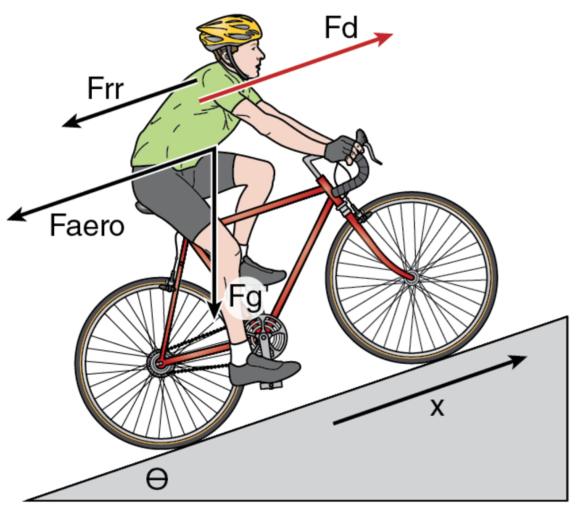Learn the importance of aerodynamics
This is an excerpt from Cycling Science by Stephen S Cheung,Mikel Zabala.
Four forces determine how fast you ride: propulsion, gravity, rolling resistance, and aerodynamic drag. Riding conditions present the rider with a continuously changing mix of these forces. The relative mix of the four forces determines what is slowing down the rider the most. Figure 9.1 illustrates the force vectors on a rider going up a hill. Modifying these four forces, the course slope, wind, and rider parameters determine the relative mix of all the forces.

Interaction of four forces determining bicycle speed.
Propulsion is the force that the cyclist generates from the muscles by transmitting torque to the crank. This force is transmitted by the chain to the rear wheel and, ultimately, to the ground by the rear tire.
Gravity pulls on the rider because of the component of vertical gravitational force that is in the direction of the bike. A purely flat section of road offers no gravitational pull, whereas a steep 20 percent climb creates substantial gravitational tug.
Rolling resistance is a force that comprises the drag arising from energy losses in the mechanics of the bicycle, from crank and frame flex, from chain and bearing resistance, and from energy losses in the tire rubber. The bearing drag is usually small compared with the other drag forces, and the tire rolling resistance is proportional to the vertical load on the tire. Rolling resistance is characterized by a parameter called the coefficient of rolling resistance that relates vertical loading of the tire to the drag force.
Aerodynamic drag is the force that pulls on a rider from behind. This force is determined by the air density (Ï), the airspeed of the bike (v), the bike and rider's aero drag coefficient (Cd), and the projected frontal area (A). We describe the aerodynamic force in detail later in this chapter.
So, compared with the other forces, how important is aerodynamic drag? To see this, let us consider a cyclist riding along a road at a power output of 300 watts and look at the relative contribution of each of the four main resistive forces on the rider. A normal 80-kilogram cyclist at a power output of 300 watts on a flat course will lose almost 90 percent of his or her power to aerodynamic losses (figure 9.2). Clearly, the greatest improvements to be made will be to refine the aerodynamic position and equipment for flat time-trial races. Rolling resistance plays a relatively minor role in the force balance. With the same rider on a 2 percent grade, gravity and aerodynamics are approximately equal in importance. Being efficient through the air is still extremely important, but rider weight is equally important. Finally, at an 8 percent grade, gravity dominates all else. Power-to-weight ratio is the primary determinant of success on steep grades. What this case illustrates is that aerodynamics plays an important role in winning on all but the steepest of grades.
Learn more about Cycling Science.
More Excerpts From Cycling ScienceSHOP

Get the latest insights with regular newsletters, plus periodic product information and special insider offers.
JOIN NOW


